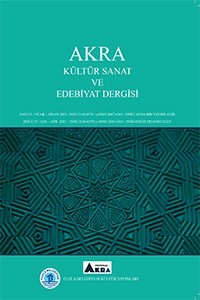Sovet Mifoloji Modelində Simvol Transformasiyasi
Hər bir ideoloji cəmiyyət mifolojidir. Onun varlığı, gerçəklikləri yaddaşda, bədii düşüncədə mövcud olan simvolların yeni modeldə təzahüründə əksini tapmışdır. Bu baxımdan mifin ölməzlik hüququ vardır. Bədii düşüncədə daim diri olan mif təkrarlanmır, öz ilkin əsasına bağlılığı qorumaqla yeni kontekstdə üzə çıxır. XX əsrin ikinci onilliyindən sonra mif artıq sosial mexanizmə çevrildi. Bu prosesdə sovet mifi, yeni mifoloji layların açılması əsasən iki yönümdə təzahürünü tapmışdı. Bəzən ənənəvi obraz dəyişmir, lakin kontekst dəyişir, mifoloji obrazın transformasiyası obrazın yeni kontekstdə meydana çıxmasına şərait yaradır. Digər tərəfdən isə, obraz yeni mif modelində təqdim olunur. Məqalədə 1930-1950- ci illər Azərbaycan şeirində bədii düşüncədə mifoloji strukturlu simvolların yaranmasında yeni ideoloji cəmiyyətin sovet kultuna təsir mexanizmi izlənilir. XX əsrin ikinci onilliyindən başlayaraq mifin sosial mexanizmə çevrilməsi prosesində yeni mif modelində ədəbi qəhrəmanın ideoloji qəhrəmanla, lider obrazının mifoloji qəhrəmanla, dini, müqəddəs məkanların yeni məkanla əvəzlənməsi müşahidə olundu. Tədqiqat zamanı bu konteksdə yeni mifoloji strukturun formalaşmasında simvolik obrazın ikili funksiyasına – obrazın mifoloji konteksdə simvollaşması və obrazın semantikasının mifoloji düşüncəyə dayalı olmasına nəzər yetirilmişdir. Qızıl əsgər mifogeminin ədəbi qəhrəmana transformasiyası gətirilən bədii nümunələr əsasında təhlil edilmişdir. Məqalədə sovet mifinin yeni strukturlu modelə çevrilməsi, proletar ədəbiyyatının türk mifoloji təsəvvürlərindən gələn obrazlara münasibəti, obraz transformasiyasının yeni simvolik modelə təsir yönümləri və folklordan gələn simvolların transformasiyasına ilk dəfə olaraq bədii və elmi materiallarla nəzər yetirilmişdir.Bu da tədqiqatın elmi yeniliyini əsaslandırır.Simvolun mif yaratma gücü ilə yanaşı, proletar ədəbiyyatının türk mifoloji təsəvvürlərindən gələn obrazlara münasibəti, obraz transformasiyasının yeni simvolik modelə təsir yönümləri araşdırılmışdır.
Anahtar Kelimeler:
mif, simvol, zaman, sovet kultu, lider obrazı
The Symbol Transformation in The Soviet Mythological Model
Every ideological society is mythological, and its existence and realities are reflected in the new model of the symbols that exist in memory and artistic thought. In this sense, the myth has the right to immortality. The myth, which is always alive in artistic thought, is not repeated, but emerges in a new context, maintaining its attachment to its original basis. After the second decade of the 20th century, myth has already become a social mechanism. In this process, the Soviet myth, the discovery of new mythological layers, manifested itself mainly in two directions. Sometimes the traditional image does not change, but the context changes, the transformation of the mythological image creates conditions for the image to appear in a new context. On the other hand, the image is presented in a new myth model. In the article is traced the mechanism of influence of the new ideological society on the Soviet cult in the formation of mythological structural symbols in artistic thought in Azerbaijani poetry of 1930-1950. Beginning from the second decade of the 20th century, in the process of transforming myth into a social mechanism, was observed a new myth model replaced the literary hero with an ideological hero, the image of a leader with a mythological hero, and religious and sacred places with a new place. During the research the dual function of the symbolic image in the formation of a new mythological structure in this context - the symbolization of the image in the mythological context and the semantics of the image based on mythological thinking is considered. The article analyzes the transformation of the myth of the golden soldier into a literary hero on the basis of the given artistic examples. In the article, the transformation of the Soviet myth into a new structural model, the attitude of proletarian literature against images consisting of Turkish mythological imaginations, the effects of image transformation on the new symbolic model? Symbols consisting of folklore are discussed for the first time with artistic and scientific elements. This justifies the scientific innovation of the research. Along with the myth-making power of the symbol, the attitude of proletarian literature to images from Turkish mythological imaginations, the influence of image transformation on the new symbolic model are studied.
Keywords:
myth symbol, proletarian literature, time, Soviet cult, image of a leader,
___
- Cavad, Əhməd (1992); Seçilmiş əsərləri, 2 cilddə, I c., Azərnəşr, Bakı.
- Cəmil, Əhməd (1975); Seçilmiş əsərləri, Azərrbaycan Dövlət Nəşriyyatı, Bakı.
- Xəlil, Zeynal (2010); XX əsr Azərbaycan poeziyası antologiyası ( 1930-cu illərin poeziyası). II kitab, Elm, Bakı.
- Levçenko M.A (2001); Poeziya proletkulta: ideologiya i ritorika revolyutsionnoy epoxi: avtoref. diss... kand.filol.nauk. SPb.
- Müşfiq, Mikayıl (2013); Seçilmiş əsərləri, Xalq Emaneti Yayımı, Bakı.
- Ordubadi, Məmməd Səid (2009); XX əsr Azərbaycan poeziyası antologiyası (1920-ci illərin poeziyası). I kitab, Elm, Bakı.
- Rəfili, Mikayıl (2010); XX əsr Azərbaycan poeziyasıı antologiyası (1930-cu illərin poeziyası). II kitab, Elm, Bakı.
- Rza, Rəsul (1969); Lenin (poema). Gənclik, Bakı.
- Şaiq, Abdulla (2003); Arazdan Turana. Nurlan, Bakı.
- Vahid, Əliağa (2010); XX əsr Azərbaycan poeziyası antologiyası (1930-cu illərin poeziyası). II kitab, Elm, Bakı.
- Vurğun, Səməd (2005); Seçilmiş əsərləri. 5 cilddə, I c., Şərq-Qərb, Bakı.
- Yakimenko E.R. Mifologiçeckie obrazı v proletarskoy poezii.https://cyberleninka. ru/arti-cle/n/mifologicheskie-obrazy-v-proletarskoy-poezii/viewer
- Yusupova Nurfiya Marsovna. Osobennosti simbolizatsii v tatarskoy poezii XX veka.https://www.gramota.net/articles/issn_1997-2911_2018_4-1_08.pdf (17.01.2018)
- ISSN: 2148-0370
- Yayın Aralığı: Yılda 3 Sayı
- Başlangıç: 2013
- Yayıncı: Tuzla Belediyesi
Sayıdaki Diğer Makaleler
Bir Sanat Sosyolojisi Örneği: Sanatın Meta Yolculuğu
Dülger Kızı Masalının Arketipsel Sembolizm Bağlamında Çözümlenmesi
Sovet Mifoloji Modelində Simvol Transformasiyasi
Sanatta ve Savaşta Yüzyılın Tanığı: Life Magazine
İki Dünya Arasında Sıkışmak: Roma Katolik Kilisesi’nde Eşcinsellik Dilemması
Halk Baytarlığı: Malatya'nın Arguvan İlçesinin Parçikan Köyü Örneği
Bedrettin KAYHAN, Rezan KARAKAŞ
Sûr-Nâme “Sultan Ahmed’in Düğün Kitabı”
Savaşa Eleştirel Yaklaşan Öncü Sanatçılar
Düşük Benlik Saygısı ve Varoluşsal Umutsuzluk T.S. Eliot's J. Alfred Prufrock'un Aşk Şarkısı 1919
